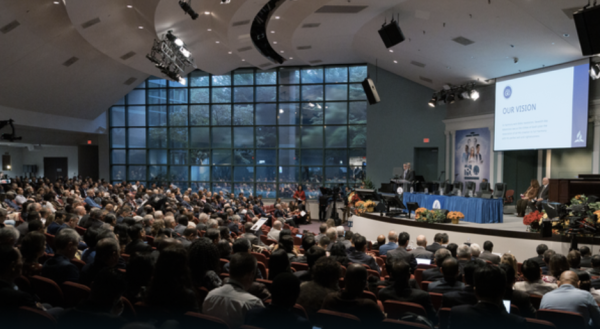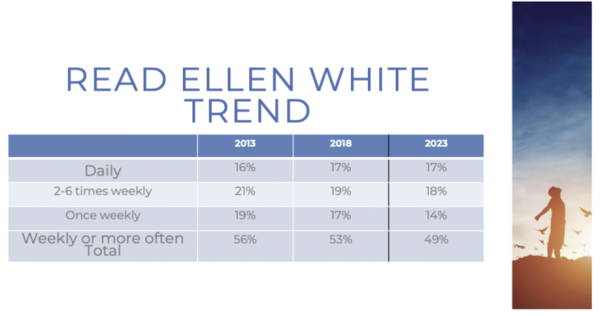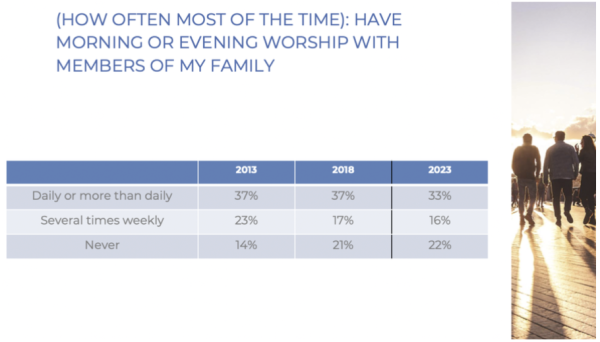Southern Asia-Pacific Division
The official website of the Southern Asia-Pacific Division of the General Conference of Seventh-day Adventists
News
Adventist World Church Leaders Announce Strategic Plan for 2025-2030

The first business session of Annual Council 2023 occurred on Friday, October 6, 2023, with a special emphasis on the mission refocus of the worldwide Seventh-day Adventist Church. The annual meetings, themed Chosen for Mission, provide an opportunity for church leadership to make special announcements to affect the Church and its mission moving forward.
Among the presentations of the first business session of Annual Council 2023 was a report from the Future Plans Working Group in which its members presented the proposed strategic plan for the next quinquennial. Mike Ryan, special assistant to the president, introduced the new plan which will be adopted at the next Annual Council in October of 2024. Ryan explained that many worldwide programs and initiatives have adopted the “I Will Go” Strategic Plan since it was adopted in 2018, so the upcoming plan for 2025-2030 will keep the name “I Will Go.”
The current strategic plan steering the mission of the Adventist Church from 2020-2025 is “I Will Go” and has three areas of emphasis, 10 objectives, and 59 key performance indicators (KPIs). These KPIs, Dr. Trim explained, must be measurable, and the way we measure them is through surveys.
Nevertheless, research indicates that while many of the 59 KPIs were successful, others missed the mark.
Dr. Trim said of Bible reading, “In the last five years, daily Bible reading has effectively plateaued…Weekly Bible reading has dropped since 2018 from 89% to 85.” The research also indicates fewer people are reading Ellen White, indicating a 2 percent drop in those who read Ellen White 2-6 times per week and a 3 percent drop in those reading once weekly.

The research also indicates a decline in family worship between 2013 and 2023, revealing that 22 percent of Adventist members surveyed globally never have morning or evening worship with members of their family.

These results were not exclusive to spiritual practice, but also to doctrinal belief. The doctrines of Salvation (Fb 4, 10, and 19) and Sabbath (FB 6, 20) were strongly understood and supported by surveyed members, but of the Holy Spirit (FB 5), Creation (FB 6), Gift of Prophecy (FB 18), Sanctuary (FB 24), and State of the Dead (FB 26) doctrines, Trim stated, “There is work to be done.”
While some aspects of the doctrine is understood and believed, others are not. For example, in 2023, 72 percent of those surveyed strongly agreed that “when people die, their bodily remains decay and they have no consciousness or activity until they are resurrected,” but 33 percent agreed or strongly agreed to the statement, “the soul is a separate, spiritual part of a person and lives on after death.” The latter is in direct opposition to the doctrine of the 26th fundamental belief.
Trim explained, “We are having these problems partly because the Church is growing. We are having new believers joining our ranks, and they are not as familiar with our beliefs.” Continuing, he called for data-driven changes, “In some parts of the world where there is rapid growth, it is among non-Christian people who sometimes accept our doctrines on the surface, but take time to…change in worldview.” He continued to reinforce the idea introduced during the LEAD Conference that we must not only evangelize new believers but also disciple those who have been baptized.
Data-Driven Preliminary Strategic Plan
The new preliminary strategic plan to guide the coming year before being officially adopted at Annual Council 2024 may have the same name, “I Will Go,” but is different in many ways.
“Reach the World: I Will Go,” adopted in 2013, had 81 KPIs. “I Will Go,” adopted in 2018, decreased to 59 KPIs. The next strategic plan of the global Seventh-day Adventist Church, called “I Will Go,” has 21 measurable goals. These measurable goals will replace KPIs altogether, allowing leaders at every structure level, and members around the world, to clearly understand the intention of the plan.
Instead of areas of emphasis, the plan will include four strategic priorities:
- COMMUNION with God
- IDENTITY in Christ
- UNITY through the Holy Spirit
- MISSION for all
If the goal is simplicity and clarity, why are there still so many measurable goals associated with the new plan?
Trim concluded his report, “We want a plan that is a good fit for the worldwide Church of which we are all proud to be a part of, and that will help us in our collective mission to reach the world, looking toward the imminent return of our Lord and Savior, Jesus Christ.”
Krause, in a series of inspiring stories from Adventist pioneers, explained how the Church achieves the mission through various methods. Faith for Today, is one method used to spread the gospel, which nearly did not happen because of opposition at the time. The Present Truth, a publication created by James White, also faced opposition and very nearly might have been abandoned, yet today, it thrives as the longest-running Christian journal in the United States, now called Adventist Review.
Sharing examples such as radio, television, and even digital evangelism, Krause concluded, “As we look at the Strategic plan, let’s take some prayer-baptized risks. Let’s venture in the power of the One who has all authority in heaven and earth, and let’s, very cautiously, very prayerfully, think twice before we vote no to any new method.”
Douglas shared the importance of mobilizing resources for the mission, saying, “It’s very important that we align our resources to our plan…Now that we have these 21 measurable goals [and] four strategic priorities, it is incumbent upon us to ensure that the resources that God has given us for mission are appropriately aligned to this mission that we will engage in.”
Köhler shared the urgency of the mission, stating, “Mission Refocus is urgent because urgency is in the DNA of the Seventh-day Adventist Church. We were born in the book of Revelation, and the book of Revelation is a book of urgency.” He emphasized this point by sharing statistics from the top ten countries with daily death rates, indicating that China, India, and the United States are the top three and that of the top ten countries, five reside in the 10/40 window.
Finally, Wilson closed this section of the business session by explaining why Total Member Involvement (TMI) is important to the strategic plan. Indicating his team of leaders at the podium with him, Wilson said, “I hope all of you as leaders at division, union, and local field…will also have a unified approach amongst your team for mission.”
He concluded, “Total member involvement, global TMI…is absolutely essential because God doesn’t ask this room to simply accomplish the mission. He asks everyone to be involved–everyone doing something for Jesus.”
Executive Committee members were given a detailed description of the I WILL GO strategic plan and invited to use it as a guide for their own leadership and to submit suggestions for improvements to the plan within the next ten months.
Rachel Ashworth, for ANN
The original version of this story was posted on the ANN Website.
Our Beliefs
Seventh-day Adventist beliefs are meant to permeate your whole life. Growing out of scriptures that paint a compelling portrait of God, you are invited to explore, experience and know the One who desires to make us whole.